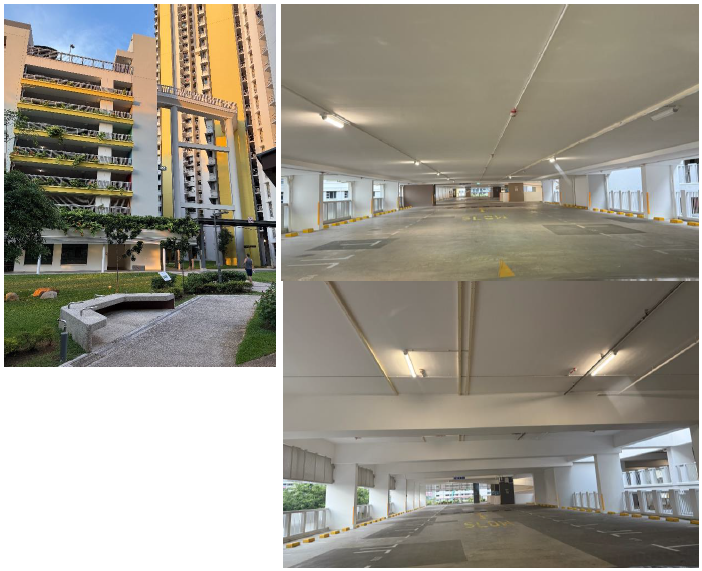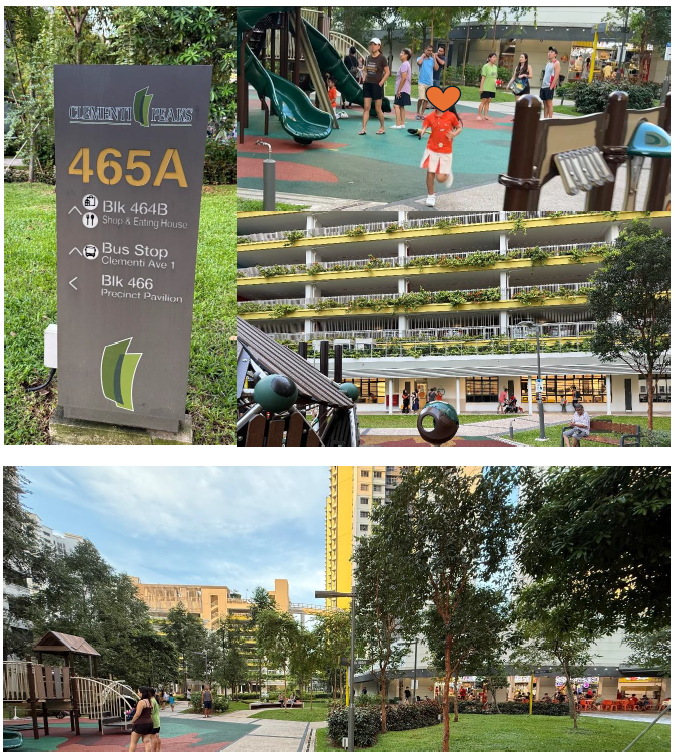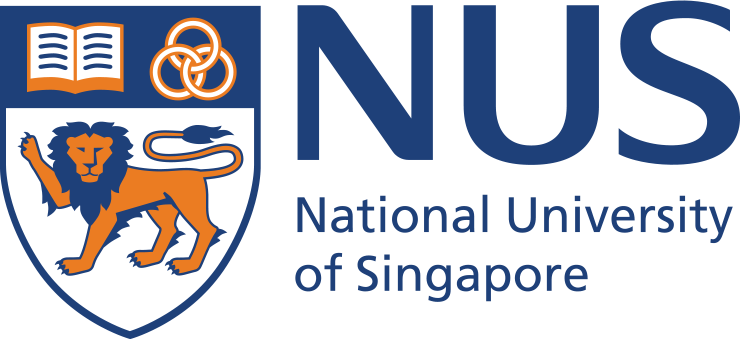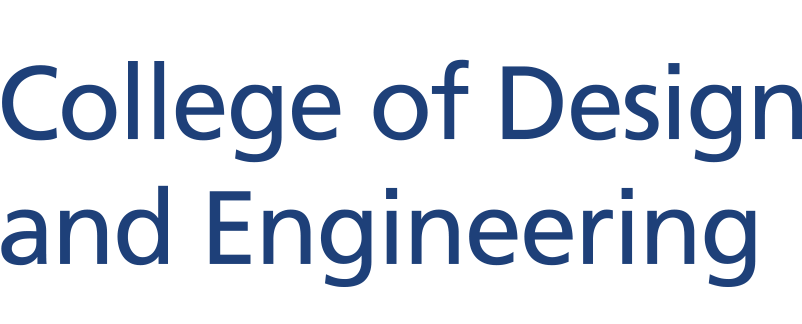Designing for Community Wellbeing: Healthy Environments and Activated Spaces
This studio addresses critical public health and community challenges affecting Singapore through human-centred design and emerging technologies. In partnership with the Clementi constituency, students will develop contextually appropriate solutions to protect over 100 children from secondhand smoke exposure at a busy childcare centre, and reimagine underutilized carpark spaces as vibrant recreational areas for residents. Working with Vanguard Assisted Living at Harmony Village's Community Care Apartments in Bukit Batok, students will also tackle challenges enabling seniors to age-in-place with dignity, addressing issues such as fall detection, prolonged inactivity, dementia-related wandering risks, social isolation, home maintenance, and last-mile delivery.
Through direct stakeholder engagement with community members, childcare staff, seniors, care providers, and families, students will tackle real-world problems that demand deep user research, ethical design thinking, systems thinking, and pragmatic innovation. If you are passionate about engineering solutions, designing concepts and spaces, making plans and engaging with stakeholders, or simply keen to do your part for the community, WE NEED YOU!
Project supervisor:
- A/Prof Lim Li Hong Idris (lhi.lim@nus.edu.sg)
Studio timeslot in Semester 2 AY2025/2026:
- Wednesday 9 am to 12 pm
From empty to engaging: plug-and-play community spaces in Clementi HDB carparks
Project partner: Clementi Constituency Office
We invite students to reimagine underutilized carpark spaces (Levels 6 and 7) in Clementi as vibrant, plug-and-play recreational areas for residents. Working directly with the Clementi constituency, HDB, local residents, and motorists, students will engage in real-world problem-solving that balances community needs with practical constraints.
Opportunity
Through conversations with our constituency leaders, we have identified a significant issue affecting our community: Levels 6 and 7 of the Clementi HDB carpark are severely underutilized. The current state of the carpark is as follows:
- Space dimensions: Multiple sections spanning 13.5m in width, with ceiling heights of 2.3m or 3.3m at different levels.
- Utilization rate: Extremely low, with vast expanses of empty parking bays
- Physical characteristics: Clean, well-maintained spaces with natural ventilation, good lighting infrastructure, and views of the surrounding estate
- Accessibility: Connected to residential blocks via walkways and elevators
While these spaces sit empty, residents in the estate face a shortage of community recreational areas where neighbours can gather, children can play safely, and social connections can flourish. This represents a missed opportunity to activate valuable community assets. However, any solution must be plug-and-play and fully reversible. The design must allow the space to be quickly converted back into a functional carpark should parking demand increase in the future. This constraint requires innovative thinking about modular, flexible, and adaptable design solutions.
This project offers a unique opportunity for students to practice engineering and designing with a purpose. Rather than completing a theoretical exercise, students will become observers and partners in their community, learning to understand the unique social, cultural, and environmental factors that shape real-world problems. This ethnographic approach allows you to design solutions that are not only technically sound but also contextually appropriate.
This is your opportunity to work on a real problem with real impact, collaborate with government agencies and community members, design solutions that balance technical requirements with human needs, and create a portfolio project that demonstrates purpose-driven design.

Five-phase journey
Phase 1: Data Collection
Gather technical data on utilization rates, spatial measurements, and structural constraints. Compile findings for submission to HDB through the Clementi constituency.
Phase 2: User Interviews
Interview residents to understand their needs, challenges, and aspirations. Learn what types of recreational spaces they hope could be added to the estate.
Phase 3: Concept Generation
Develop multiple design concepts based on research insights. Present to residents, gather feedback through community engagement sessions, and iterate based on stakeholder input.
Phase 4: Prototyping
Build a working prototype that meets the plug-and-play requirement. Consider materials, assembly methods, structural integrity, safety, and develop installation/removal procedures.
Phase 5: Validation
Test the prototype with residents, motorists, HDB, and constituency leaders. Document feedback, refine the design, and prepare final recommendations for implementation.
Skills students will develop
Technical Skills: Spatial analysis, CAD modelling, structural design for modular systems, materials selection, safety and accessibility compliance.
Design Thinking: User research and ethnographic methods, needs assessment, iterative prototyping, stakeholder engagement, context-sensitive design.
Professional Skills: Working with government agencies, presenting to diverse audiences, navigating regulations, managing long-term projects, interdisciplinary collaboration.
Social Consciousness: Understanding community needs beyond specifications, recognizing social and cultural factors, balancing stakeholder interests, developing empathy through community engagement.
Breathing safe: community-led solutions to reduce secondhand smoke exposure around childcare facilities
Project partner: Clementi Constituency Office
At Clementi Peaks, a large childcare centre serves over 100 children daily. Located in a vibrant community hub near three playgrounds, a busy coffee shop, and a bus stop, this area sees high foot traffic during peak hours when children are arriving, leaving, and playing outdoors.
The Health Risk
Parents and childcare staff have consistently observed secondhand smoke exposure affecting children in these common areas. During peak hours—when children are most active outdoors—smoking in and around the playgrounds, walkways near the childcare centre, and outdoor dining areas creates unavoidable exposure to harmful tobacco smoke.
The Challenge
Young children are particularly vulnerable to secondhand smoke, which can cause respiratory infections, asthma attacks and long-term health complications. Despite existing regulations, the current situation requires contextually appropriate solutions that balance community needs, enforcement realities, and child safety.
The Complexity
This is not just a technical or regulatory problem—it's a social and behavioural challenge requiring deep understanding of:
- How residents and visitors use these shared spaces
- Cultural norms and social dynamics around smoking
- Physical design factors that concentrate or disperse smoke
- The perspectives of multiple stakeholders: parents, smokers, childcare operators, coffee shop patrons, and residents
Don't just practice being an engineer or designer. Become an advocate for child health and community wellbeing. This is your opportunity to tackle a real public health challenge affecting over 100 young children daily, navigate the complexity of behaviour change and policy implementation, and create solutions that could be scaled to protect children across Singapore. You will learn that protecting children's health requires more than technical solutions—it demands understanding human behaviour, navigating competing interests, and designing interventions that work within complex social systems.

Five-phase journey
Phase 1: Understanding the Context
Document smoking patterns, peak usage times, air flow and ventilation characteristics, and spatial layouts. Analyse how people move through and use the spaces. Map where smoking occurs in relation to children's activities. Understand existing regulations and their enforcement challenges.
Phase 2: Stakeholder Engagement
Conduct interviews with multiple stakeholder groups to understand diverse perspectives and needs.
Phase 3: Solution Development
Based on research insights, develop multiple intervention concepts that might include:
- Designated smoking zones that minimize child exposure
- Signage and wayfinding strategies
- Behavioural nudges and environmental cues
Present concepts to stakeholders and iterate based on feedback. Solutions must be practical, enforceable, and respectful of all community members.
Phase 4: Prototyping & Testing
Develop and implement pilot interventions. This might involve temporary installations, behavioural experiments, or policy trials. Measure effectiveness through observation, air quality monitoring, and stakeholder feedback.
Phase 5: Validation & Recommendations
Work with the Clementi Constituency to present findings and recommendations to Town Council, NEA, and HDB. Develop implementation guidelines, cost analyses, and scaling strategies. Document lessons learned for application to other childcare centres facing similar challenges.
Skills students will develop
Technical Skills: Environmental monitoring, air quality assessment, spatial analysis, ventilation design, materials selection, signage and wayfinding systems
Design Thinking: Behavioural analysis, stakeholder mapping, intervention prototyping, systems thinking
Professional Skills: Multi-stakeholder negotiation, presenting to government agencies, navigating regulatory frameworks, community engagement, translating technical findings for diverse audiences
Social Consciousness: Understanding health equity issues, recognizing vulnerable populations, balancing individual rights with collective wellbeing, designing for behaviour change
Enabling ageing-in-place with dignity: innovation for community care apartments
Project partner: Vanguard Assisted Living (Harmony Village @ Bukit Batok)
Harmony Village's Community Care Apartments represent an innovative housing model where HDB-owned apartments are leased to seniors, with shared communal facilities including meeting rooms, coffee lounges, exercise areas, and gardens. The food centre on Level 1 and garden on Level 2 provide easy accessibility for residents.
Vanguard Assisted Living's Community-Based Care Model brings care directly to residents' homes through preventive care, social participation, housing support, custodial care, caregiver support, and building a sense of purpose. The goal: enable seniors to age-in-place in their own homes, with dignity and appropriate care.
The Challenges
As the senior population grows, Vanguard Assisted Living has identified seven critical challenges requiring innovative, practical, and human-centred solutions:
- Fall and Hazard Detection in Shared Spaces. Seniors are at high risk of falls in communal areas. Delayed detection leads to serious complications and loss of confidence.
- Prolonged Inactivity of Seniors at Home. Many seniors spend extended periods alone with minimal activity. This accelerates physical decline, cognitive deterioration, and emotional distress.
- Dementia Residents at Risk of Getting Lost. Increasing residents with cognitive impairment may wander from premises, unable to find their way home, facing serious risks.
- Social Isolation of Introverted Seniors. Introverted residents avoid group activities, leading to profound isolation even within a community setting. Traditional outreach doesn't reach these individuals.
- Home Maintenance and Security. Seniors struggle with home maintenance at high and unreachable areas and may be vulnerable to security risks.
- Last-Mile Delivery. Seniors cannot easily collect deliveries or carry groceries. When food or groceries are delivered, they are not able to hear the doorbell or knocking on the door.
These photos demonstrate thoughtfully designed spaces that balance communal living with individual needs — but also reveal the challenges: How do we monitor wellbeing without invasive surveillance? How do we encourage introverts to use facilities? How do we keep cognitively impaired residents safe? How do we ensure isolated seniors stay healthy and connected?
What students will do
We invite student innovators to develop solutions that enable seniors to age with dignity, safety, and meaningful social connection.
Phase 1: Deep Ethnographic Research
Shadow staff, observe facility usage, document patterns, understand constraints and ethical frameworks.
Phase 2: Needs Analysis & Problem Framing
Select 1 or 2 challenge areas, map stakeholder ecosystems, develop user personas, define success criteria balancing functional needs with emotional wellbeing.
Phase 3: Concept Generation & Co-Design
Generate multiple solutions through design workshops with residents, staff, and families. Consider technology (sensors, apps, monitoring), physical environment (spatial modifications, wayfinding), social programs (community building, engagement), service design (workflows, protocols), and policy (balancing safety with autonomy).
Phase 4: Prototyping & Pilot Testing
Build working prototypes, test with residents or operators in real settings, measure both quantitative outcomes and qualitative experiences, iterate based on feedback, address privacy and ethical concerns.
Phase 5: Validation & Implementation Planning
Present to Vanguard leadership, develop implementation guidelines (setup, training, onboarding, maintenance, costs), prepare recommendations for scaling to other facilities.
Skills students will develop
Aging-Focused Design: Understanding aging physiology, cognitive changes, emotional needs; designing for declining abilities while maintaining dignity
Healthcare Innovation: Working within regulations, privacy laws (PDPA), ethical frameworks; balancing safety with autonomy
User Research with Vulnerable Populations: Conducting sensitive interviews, building trust, understanding diverse abilities
Ethical Design: Addressing privacy, surveillance, autonomy, dignity, consent, and power dynamics in care settings
Service Design: Mapping workflows, designing protocols, training staff, ensuring sustainable implementation


